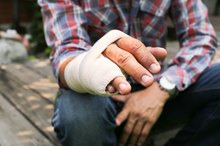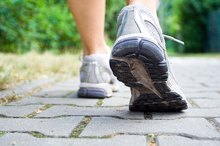Benefits of Vitamin D 5000 IU
Vitamin D is essential for bone health and can help keep you from getting sick or suffering from disease. According to James Dowd and Diane Stafford, authors of "The Vitamin D Cure," you need far more vitamin D than you get from being in the sun for a few minutes a day 1. While sunlight is an important source of vitamin D, you also need to eat foods rich in this important vitamin or you need to take a supplement to increase your intake. The current recommendation is 200 IU per day, but you may benefit from quite a bit more if you are seriously deficient. Ask your doctor if 5000 IU per day is safe for you and whether it can help you replenish your vitamin D levels.
Increases Bone Health
Vitamin D is an essential vitamin that helps your bones absorb calcium, say Frank Murray and Ronald L. Hoffman, authors of "Sunshine and Vitamin D: A Comprehensive Guide to the Benefits of the 'Sunshine Vitamin'." Consuming enough vitamin D also aids your body in bone mineralization, so that you do not develop rickets, a serious disorder that results in soft bones 2. Eating vitamin-D-rich foods or taking a supplement to help you reach 5000 IU will result in stronger bones and will help your body hold onto more of the calcium needed to retain your bone strength. You may be a candidate to take such a high dose of vitamin D if you have been tested and have soft bones or significant amounts of bone loss.
- Vitamin D is an essential vitamin that helps your bones absorb calcium, say Frank Murray and Ronald L. Hoffman, authors of "Sunshine and Vitamin D: A Comprehensive Guide to the Benefits of the 'Sunshine Vitamin'."
- Eating vitamin-D-rich foods or taking a supplement to help you reach 5000 IU will result in stronger bones and will help your body hold onto more of the calcium needed to retain your bone strength.
Helps Reduce Heart Disease
Can You Exercise the Pain of Hip Bursitis Away?
Learn More
According to Dowd and Stafford, a vitamin D deficiency can leech calcium, potassium, magnesium and protein from your bones, which can result in an increase in the inflammation in your body 1. Deficiencies also increase abdominal fat, which raises inflammation rates as well. High inflammation rates have been associated with a higher risk of heart disease and stroke. Loss of important nutrients, such as potassium and magnesium can also raise your blood pressure and put unnecessary stress on your heart. Increasing your intake of vitamin D to reach 5000 IU per day is one way that some doctors feel can help decrease inflammation and other health problems and can also help you keep your heart healthy. This may be particularly true if you already experience heart problems or if you have a strong family history of heart disease. However, again, it is important that you consult with your doctor before taking high doses of vitamin D.
- According to Dowd and Stafford, a vitamin D deficiency can leech calcium, potassium, magnesium and protein from your bones, which can result in an increase in the inflammation in your body 1.
Can Increase Metabolism And Promote Weight Loss
Large amounts of vitamin D can help boost your metabolism so you are able to lose weight easier, say Murray and Hoffman. Dowd and Stafford add that sufficient intake of vitamin D can help you exercise more effectively and can help increase the overall strength of your muscles 1. Vitamin D also works to help your body maintain muscle mass, making it easier for you to increase the intensity of your workouts if you want to shed pounds. As you get stronger, your body will be able to retain and use vitamin D more efficiently, which will help improve all aspects of your health, say Dowd and Stafford 1. You may benefit from doses as high as 5000 IU if you are significantly overweight or if other weight loss approaches have not worked for you.
- Large amounts of vitamin D can help boost your metabolism so you are able to lose weight easier, say Murray and Hoffman.
- Dowd and Stafford add that sufficient intake of vitamin D can help you exercise more effectively and can help increase the overall strength of your muscles 1.
Related Articles
References
- "The Vitamin D Cure"; James Dowd and Diane Stafford; 2010
- "Sunshine and Vitamin D: A Comprehensive Guide to the Benefits of the 'Sunshine Vitamin'"; Frank Murray and Ronald L. Hoffman; 2008
- Holick MF, Gordon CM. Patient Guide to Vitamin D Deficiency. The Journal of Clinical Endocrinology & Metabolism. 2011;96(7):1-2. doi:10.1210/jcem.96.7.zeg33a
- Sunyecz JA. The use of calcium and vitamin D in the management of osteoporosis. Ther Clin Risk Manag. 2008;4(4):827-836. doi:10.2147/tcrm.s3552
- Giovannucci E, Liu Y, Hollis BW, Rimm EB. 25-hydroxyvitamin D and risk of myocardial infarction in men: a prospective study. Arch Intern Med. 2008;168(11):1174-1180. doi:10.1001/archinte.168.11.1174
- Gorham ED, Garland CF, Garland FC, et al. Optimal vitamin D status for colorectal cancer prevention: a quantitative meta analysis. Am J Prev Med. 2007;32(3):210-216. doi:10.1016/j.amepre.2006.11.004
- Lappe JM, Travers-Gustafson D, Davies KM, Recker RR, Heaney RP. Vitamin D and calcium supplementation reduces cancer risk: results of a randomized trial. The American Journal of Clinical Nutrition. 2007;85(6):1586-1591. doi:10.1093/ajcn/85.6.1586
- Prentice RL, Pettinger MB, Jackson RD, et al. Health risks and benefits from calcium and vitamin D supplementation: Women’s Health Initiative clinical trial and cohort study. Osteoporos Int. 2013;24(2):567-580. doi:10.1007/s00198-012-2224-2
- Urashima M, Segawa T, Okazaki M, Kurihara M, Wada Y, Ida H. Randomized trial of vitamin D supplementation to prevent seasonal influenza A in schoolchildren. Am J Clin Nutr. 2010;91(5):1255-1260. doi:10.3945/ajcn.2009.29094
- Salehpour A, Hosseinpanah F, Shidfar F, et al. A 12-week double-blind randomized clinical trial of vitamin D₃ supplementation on body fat mass in healthy overweight and obese women. Nutr J. 2012;11:78. doi:10.1186/1475-2891-11-78
- Carrillo AE, Flynn MG, Pinkston C, et al. Impact of vitamin D supplementation during a resistance training intervention on body composition, muscle function, and glucose tolerance in overweight and obese adults. Clin Nutr. 2013;32(3):375-381. doi:10.1016/j.clnu.2012.08.014
- Marcinowska-Suchowierska E, Kupisz-Urbańska M, Łukaszkiewicz J, Płudowski P, Jones G. Vitamin D Toxicity-A Clinical Perspective. Front Endocrinol. 2018;9:550. doi:10.3389/fendo.2018.00550
- Ross AC, Manson JE, Abrams SA, et al. The 2011 report on dietary reference intakes for calcium and vitamin D from the Institute of Medicine: what clinicians need to know. J Clin Endocrinol Metab. 2011;96(1):53-58. doi:10.1210/jc.2010-2704
- Bouillon R, Van Schoor NM, Gielen E, et al. Optimal vitamin D status: a critical analysis on the basis of evidence-based medicine. J Clin Endocrinol Metab. 2013;98(8):E1283-E1304. doi:10.1210/jc.2013-1195
- American Academy of Dermatology. Position Statement of Vitamin D. 2010.
- Taksler GB, Cutler DM, Giovannucci E, Keating NL. Vitamin D deficiency in minority populations. Public Health Nutr. 2015;18(3):379-391. doi:10.1017/S1368980014000457
- Holick MF, Binkley NC, Bischoff-Ferrari HA, et al. Evaluation, treatment, and prevention of vitamin D deficiency: an Endocrine Society clinical practice guideline. J Clin Endocrinol Metab. 2011;96(7):1911-1930. doi:10.1210/jc.2011-0385
- Cannell JJ, Vieth R, Umhau JC, et al. Epidemic Influenza and Vitamin D. Epidemiol Infect. 2006; 134:1129-40.
- Carrillo AE1, Flynn MG, Pinkston C, Markofski MM, Jiang Y, Donkin SS, Teegarden D. Impact of Vitamin D Supplementation During a Resistance Training Intervention on Body Composition, Muscle Function, and Glucose Tolerance in Overweight and Obese Adults. Clin Nutr. 2013 Jun;32(3):375-81. doi: 10.1016/j.clnu.2012.08.014. Epub 2012 Aug 31.
- Ginde AA, Mansbach JM, Camargo CA, Jr. Association Between Serum 25-Hydroxyvitamin D Level and Upper Respiratory Tract Infection in the Third National Health and Nutrition Examination Survey. Arch Intern Med. 2009; 169:384-90.
- Giovannucci E, Liu Y, Hollis BW, Rimm EB. 25-hydroxyvitamin D and Risk of Myocardial Infarction in Men: a Prospective Study. Arch Intern Med. 2008; 168:1174-80.
- Gorham ED, Garland CF, Garland FC, Grant WB, Mohr SB, Lipkin M, Newmark HL, Giovannucci E, Wei M, Holick MF. Optimal Vitamin D Status for Colorectal Cancer Prevention: a Quantitative Meta-analysis. Am J Prev Med. 2007 Mar;32(3):210-6.
- Heaney, Robert P. “The Vitamin D Requirement in Health and Disease.” The Journal of Steroid Biochemistry & Molecular Biology 97 (2005):13-9.
- Holick MF. Vitamin D. In: Shils M, Olson J, Shike M, Ross AC, ed. Modern Nutrition in Health and Disease, 9th ed. Baltimore: Williams and Wilkins, 1999.
- National Institutes of Health Office of Dietary Supplements. Vitamin D: Dietary Supplement Fact Sheet. University of Ottawa Evidence-based Practice Center. Effectiveness and Safety of Vitamin D in Relation to Bone Health. Agency for Healthcare Research and Quality. Aug 2007: 07-E013.
- Salehpour A1, Hosseinpanah F, Shidfar F, Vafa M, Razaghi M, Dehghani S, Hoshiarrad A, Gohari M. A 12-week Double-blind Randomized Clinical Trial of Vitamin D₃ Supplementation on Body Fat Mass in Healthy Overweight and Obese Women. Nutr J. 2012 Sep 22;11:78. doi: 10.1186/1475-2891-11-78.
- Urashima M, Segawa T, Okazaki M, Kurihara M, Wada Y, Ida H. Randomized Trial of Vitamin D Supplementation to Prevent Seasonal Influenza A in Schoolchildren. Am J Clin Nutr. 2010 91:1255-60. Epub 2010 Mar 10.
- Wilkins, Consuelo H. and Yvette I. Sheline, et al. “Vitamin D Deficiency Is Associated with Low Mood and Worse Cognitive Performance in Older Adults.” American Journal of Geriatric Psychiatry 14 (2006): 1032-40.
Writer Bio
Sara Ipatenco has taught writing, health and nutrition. She started writing in 2007 and has been published in Teaching Tolerance magazine. Ipatenco holds a bachelor's degree and a master's degree in education, both from the University of Denver.







